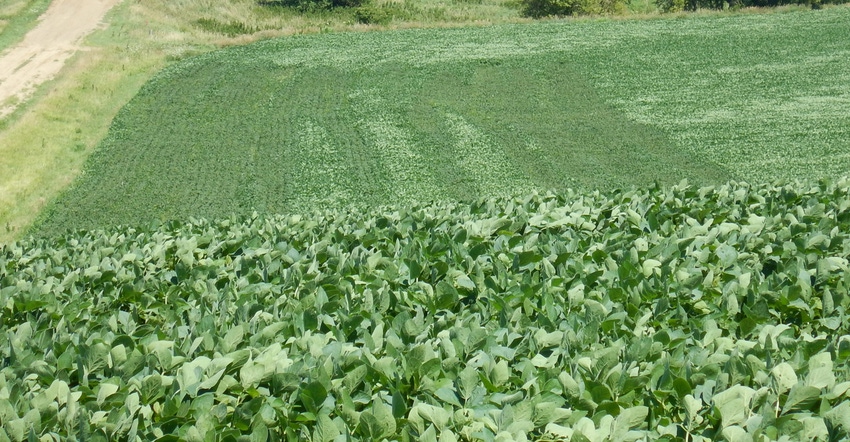April 21, 2017

This is where all that time I spent looking at plants that were injured — and ones that had symptoms of dicamba herbicide injury but we hadn’t dinged up — comes in handy. Because so little exposure to a plant growth regulator type of herbicide can elicit symptoms, we see a little bit of PGR injury to soybeans and other sensitive crops and plants every year. On the other hand, there are also a fair number of situations that mimic PGR injury close enough to create a lot of confusion.
Group 14 herbicides like Blazer, Cobra and Flexstar can generate a few calls if we happen to spray them during a stretch of cooler weather when we see less leaf burn. While they can cause crinkling on new leaves right after application, the next sets are almost always symptom-free.
We also get calls about the drawstring effect that Group 15 herbicides can have on young soybean plant leaves, especially in cool, damp conditions.
While we haven’t seen a lot of them in a few years (hopefully, that trend continues), soybean aphid feeding can cause leaf cupping occasionally. It usually occurs with relatively high numbers so we see the aphids and often don’t even note the cupping. Occasionally we see cupping with a combination of lower aphid numbers, and heat and moisture stress, which is typically when I get calls about it being potential PGR injury.
Confusing disease symptoms
Viral diseases are another culprit when it comes to PGR lookalikes in soybeans; pathogens that come to mind are bean pod mottle virus, soybean mosaic virus, alfalfa mosaic virus and tobacco streak virus. Depending on the virus and a slug of other factors, we can see leaf cupping, bumpy leaf surfaces or other leaf deformation symptoms that can generate questions about PGR drift or contamination. While some of the symptoms might mimic PGRs, they aren’t collectively a perfect match. Good scouting finds that usually the symptoms and their patterns (or lack of) can be differentiated from herbicide drift or contamination.
Environmental extremes can create PGR-type symptoms as well. Drought-stressed plants can display symptoms similar to the diseases mentioned above or PGR exposure. Even with adequate soil moisture, I have seen hot, windy weather do the same thing, while leaving hints like symptom-free plants near sheltered areas, such as windbreaks, terraces and buildings.
Some of these same lookalikes can show up on other plants, along with a slew of other conditions that can cause PGR-type symptoms. In working through these issues and finding resolution with parties who are concerned about these symptoms on their plants, sometimes outside expertise is a good option.
They can be challenging to identify and their time is at a premium, but there are experts in horticulture, forestry and related fields across the state. While I was reluctant to bring them in early during my retail career, once I started working with experts like these, I discovered it was good for all parties involved. We found that they could do a lot better job of differentiating herbicide injury from lookalikes and have the explanations make sense to everyone. On occasions where they found evidence that our herbicides had caused the symptoms, they were better able to help estimate any resulting damages.
What about residue testing?
Testing a plant to see if it contains dicamba residue is hit-and-miss. Doing a little online research on pesticide residue testing gives you an idea of what testing can and, importantly, cannot do. I’ve been in situations where we were certain there was herbicide injury, but someone wanted residue testing done to “document” it. Samples were taken in a timely manner, handled and shipped properly, but nothing showed up.
It turns out sometimes pesticide residues can be metabolized and below detectable levels before the injury is noticed and samples are taken and processed. As you learn more about residue testing, you become more familiar with when it will help and when it might not. That’s relevant since residue testing isn’t cheap. Hopefully, sharing some of what I learned on the fly will make any residue testing you consider more successful, or save you money and frustration.
While the state Pesticide Bureau has a lab for their samples, most independently taken samples go to commercial labs. With most labs having their information online, you can get a rough idea of what they can detect, cost, turnaround time, and how to collect, handle and ship samples.
McGrath is the On-Farm Research and Extension coordinator for the Iowa Soybean Research Center at Iowa State University.
About the Author(s)
You May Also Like






